Picture this: the haunting call to prayer echoes across terracotta rooftops as the sun sets behind the Atlas Mountains, casting the Red City in a golden glow that has mesmerized travelers for over a thousand years. Welcome to Marrakech, where ancient traditions dance with modern life in a symphony of colors, scents, and sounds that will awaken every sense you possess.
This is THE definitive guide to experiencing Marrakech in all its magnificent complexity. Whether you’re seeking spiritual enlightenment in centuries-old mosques, hunting for treasures in labyrinthine souks, or savoring tagines that have been perfected over generations, this comprehensive guide will unlock the secrets of Morocco most captivating imperial city.
Marrakech isn’t just a destination it’s a transformative experience that blends Berber heritage, Arab culture, and French colonial influences into something utterly unique. From the moment you step into Jemaa el-Fna Square and feel the pulse of this living theater, you’ll understand why Marrakech has been enchanting visitors since traders first crossed the Sahara Desert centuries ago.
Iconic Landmarks & Historical Sites
1. Immerse Yourself in Jemaa el-Fna Square
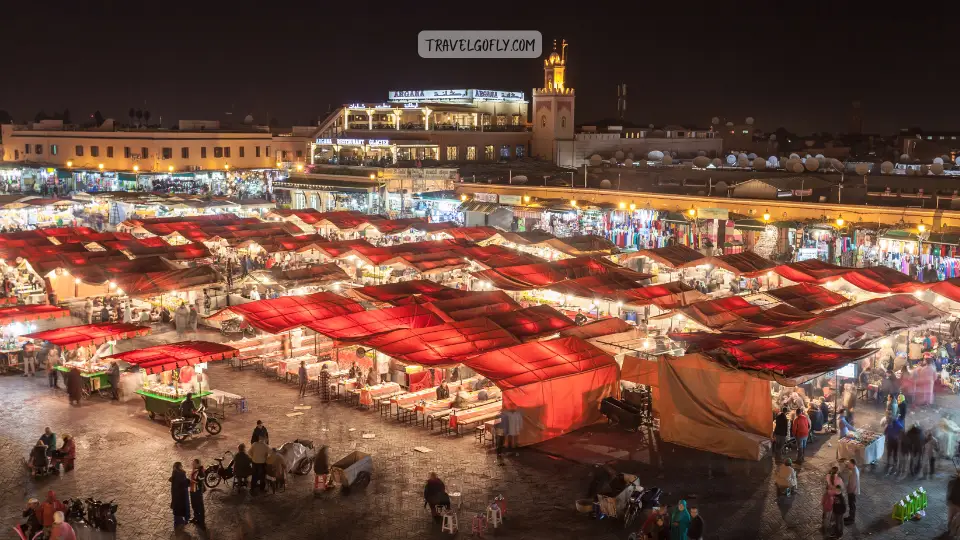 The heart of Marrakech beats strongest in Jemaa el-Fna, a UNESCO World Heritage site that transforms magically from dawn to dusk. This isn’t just a square it’s a living theater where storytellers weave ancient tales in Arabic, Berber musicians play traditional instruments, and the aroma of grilled meat mingles with the scent of orange blossoms.
The heart of Marrakech beats strongest in Jemaa el-Fna, a UNESCO World Heritage site that transforms magically from dawn to dusk. This isn’t just a square it’s a living theater where storytellers weave ancient tales in Arabic, Berber musicians play traditional instruments, and the aroma of grilled meat mingles with the scent of orange blossoms.
During daylight hours, watch henna artists create intricate designs and snake charmers perform their hypnotic acts. As evening approaches, the square undergoes its most dramatic transformation. Food stalls materialize as if by magic, creating Morocco largest open-air restaurant where you can feast on everything from snail soup to lamb mechoui while local musicians provide an authentic soundtrack.
Insider Tip: Visit during sunset for the most atmospheric experience. Claim a rooftop cafe spot early for the best views, and always negotiate prices before any interaction with performers or vendors. The square is busiest between 6-9 PM when locals come to dine and socialize.
Time Needed: Allow 2-3 hours minimum, though you could easily spend an entire evening here.
2. Discover the Architectural Marvel of Koutoubia Mosque
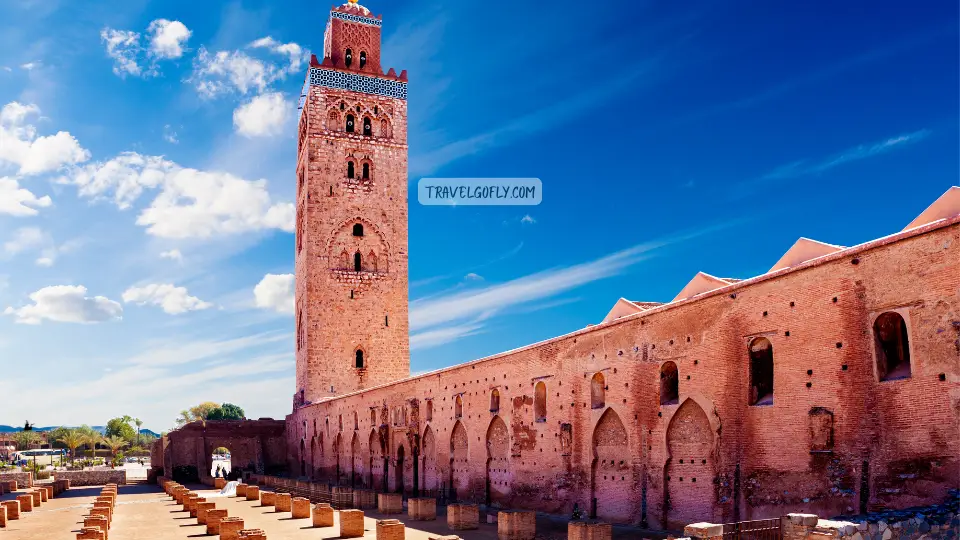 Rising 253 feet above Marrakech skyline, the Koutoubia Mosque minaret serves as both a spiritual beacon and the city most recognizable landmark. Built in the 12th century during the Almohad dynasty, this masterpiece of Islamic architecture influenced mosque design across the Maghreb and even Spain Giralda tower in Seville.
Rising 253 feet above Marrakech skyline, the Koutoubia Mosque minaret serves as both a spiritual beacon and the city most recognizable landmark. Built in the 12th century during the Almohad dynasty, this masterpiece of Islamic architecture influenced mosque design across the Maghreb and even Spain Giralda tower in Seville.
While non-Muslims cannot enter the mosque itself, the surrounding gardens offer peaceful respite and excellent photo opportunities. The intricate geometric patterns adorning the minaret tell stories of mathematical precision and spiritual symbolism that have inspired artists and architects for centuries.
Insider Tip: Visit during the evening call to prayer for an incredibly moving experience. The gardens are most beautiful during spring when orange trees bloom. Early morning visits offer the best lighting for photography.
Time Needed: 30-45 minutes for exploration and photography.
3. Step Back in Time at Ben Youssef Madrasa
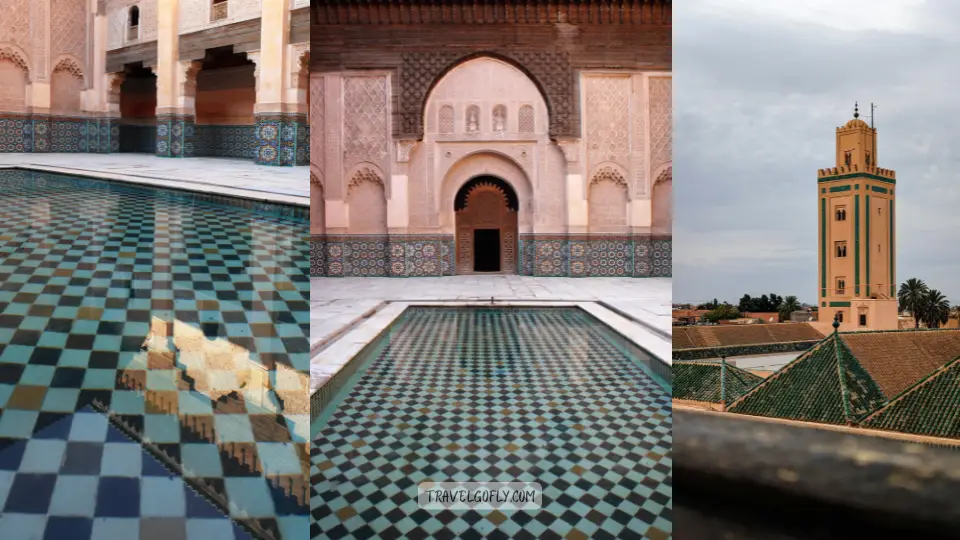 Once the largest Islamic college in North Africa, Ben Youssef Madrasa stands as a testament to Morocco scholarly heritage. Built in the 14th century and expanded in the 16th century, this architectural gem housed up to 900 students in its tiny dormitory cells.
Once the largest Islamic college in North Africa, Ben Youssef Madrasa stands as a testament to Morocco scholarly heritage. Built in the 14th century and expanded in the 16th century, this architectural gem housed up to 900 students in its tiny dormitory cells.
Every surface tells a story through intricate cedar wood carvings, zellij tilework, and stucco decorations that create a meditative atmosphere. The central courtyard, with its marble columns and reflecting pool, exemplifies the Islamic concept of paradise on earth.
Insider Tip: Visit early morning or late afternoon when the light creates magical shadows through the carved screens. Photography is allowed, but flash can damage the delicate decorations. Entry costs around 50 MAD ($5).
Time Needed: 1-1.5 hours to fully appreciate the craftsmanship.
4. Marvel at Saadian Tombs
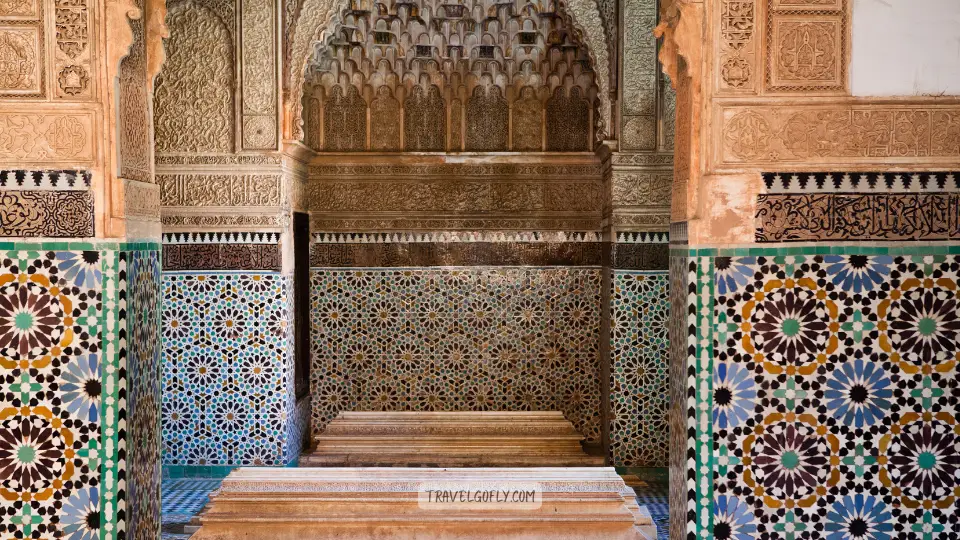 Hidden for centuries and rediscovered in 1917, the Saadian Tombs offer a glimpse into royal burial practices of the 16th and 17th centuries. The mausoleums house 66 members of the Saadian dynasty in chambers adorned with Italian Carrara marble, intricate tilework, and cedar ceilings that rival any palace.
Hidden for centuries and rediscovered in 1917, the Saadian Tombs offer a glimpse into royal burial practices of the 16th and 17th centuries. The mausoleums house 66 members of the Saadian dynasty in chambers adorned with Italian Carrara marble, intricate tilework, and cedar ceilings that rival any palace.
The Chamber of the Twelve Columns, where Sultan Ahmad al-Mansur rests, showcases the pinnacle of Moroccan decorative arts. The peaceful gardens surrounding the tombs provide a contemplative space where bougainvillea and orange trees create a serene atmosphere.
Insider Tip: The entrance through a narrow passage in the Kasbah Mosque wall adds to the mystique. Visit during midday when sunlight illuminates the interior decorations most beautifully. Entry fee is 70 MAD ($7).
Time Needed: 45 minutes to 1 hour.
Souks & Shopping Experiences
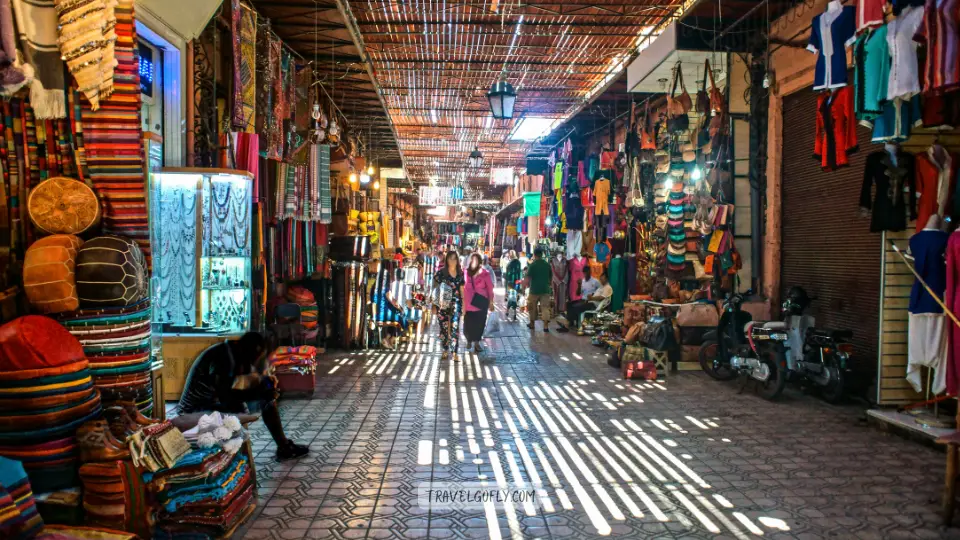 The souks of Marrakech form a medieval shopping mall where every narrow alley leads to new discoveries. Organized by craft and trade, these covered markets have operated continuously for nearly a thousand years, creating an authentic commercial experience that modern shopping centers can’t replicate.
The souks of Marrakech form a medieval shopping mall where every narrow alley leads to new discoveries. Organized by craft and trade, these covered markets have operated continuously for nearly a thousand years, creating an authentic commercial experience that modern shopping centers can’t replicate.
Start your souk adventure in the main artery of Souk Semmarine, where carpets from the High Atlas compete for wall space with leather goods from local tanneries. The air thick with incense and spices creates an intoxicating atmosphere that’s uniquely Marrakech.
Insider Tip: Always negotiate initial prices are typically 3-4 times the expected selling price. Learn basic numbers in Arabic to improve your bargaining position. Carry small denominations and be prepared to walk away to secure better deals. Thursday and Friday mornings are less crowded.
Time Needed: Allow a minimum of 2-3 hours, though you could spend days exploring every alley.
6. Experience the Spice Markets
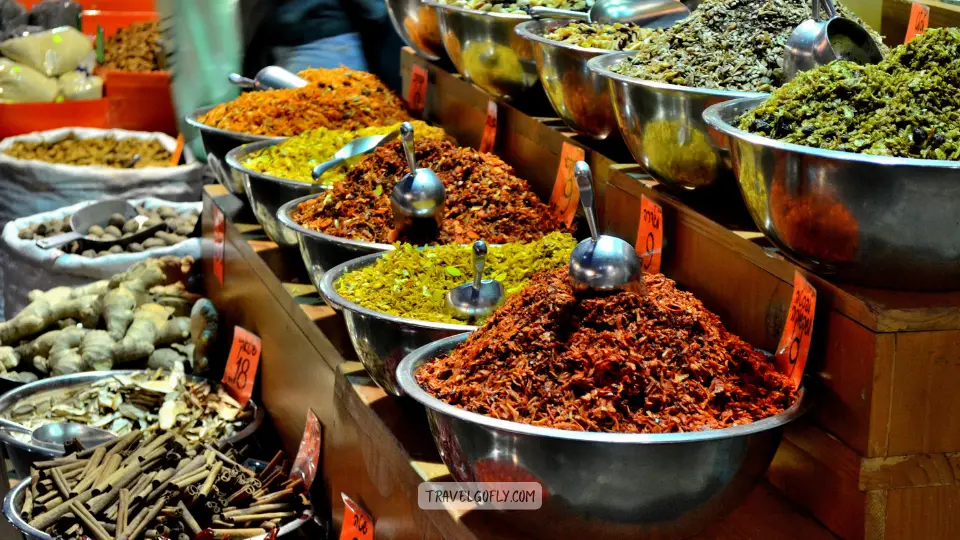 The spice souks assault your senses in the most delightful way, with pyramids of saffron, cinnamon, and ras el hanout creating a rainbow of flavors and aromas. Local spice merchants, often following family traditions spanning generations, will explain the medicinal properties of each herb and spice while preparing custom blends for your culinary adventures.
The spice souks assault your senses in the most delightful way, with pyramids of saffron, cinnamon, and ras el hanout creating a rainbow of flavors and aromas. Local spice merchants, often following family traditions spanning generations, will explain the medicinal properties of each herb and spice while preparing custom blends for your culinary adventures.
Beyond cooking spices, you’ll discover cosmetic ingredients like rose petals for beauty treatments, henna for body art, and traditional remedies for everything from digestive issues to insomnia.
Insider Tip: Buy saffron by the gram rather than pre-packaged amounts for better quality and prices. Ask for samples to taste before purchasing spice blends. Many vendors speak multiple languages and enjoy sharing their knowledge about traditional uses.
Time Needed: 30-45 minutes for browsing, longer if you’re seriously shopping.
7. Browse the Artisan Workshops
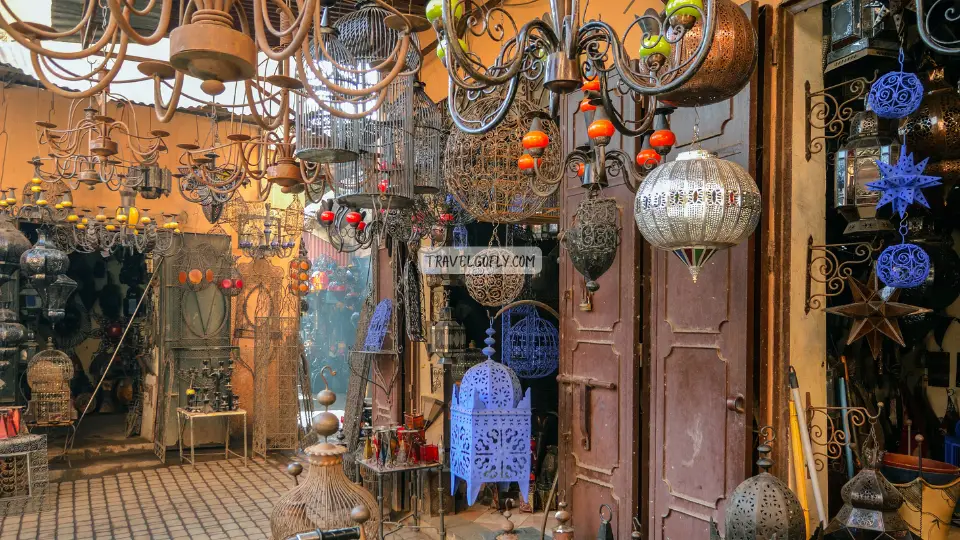 Hidden within the souk maze, family workshops continue crafts passed down through generations. Watch leatherworkers transform raw hides into buttery-soft bags and shoes, metalworkers hammer intricate patterns into brass lanterns, and woodcarvers create geometric masterpieces from thuya wood.
Hidden within the souk maze, family workshops continue crafts passed down through generations. Watch leatherworkers transform raw hides into buttery-soft bags and shoes, metalworkers hammer intricate patterns into brass lanterns, and woodcarvers create geometric masterpieces from thuya wood.
These aren’t tourist shows they’re working businesses where master craftsmen take pride in maintaining traditional techniques. Many workshops welcome visitors and offer insights into their time-honored processes.
Insider Tip: Photography requires permission and sometimes a small tip. The best workshops are often down narrow side alleys don’t hesitate to explore. Commissioned pieces take several days to weeks depending on complexity.
Time Needed: 1-2 hours to visit multiple workshops.
Gardens & Palaces
8. Find Tranquility in Majorelle Garden
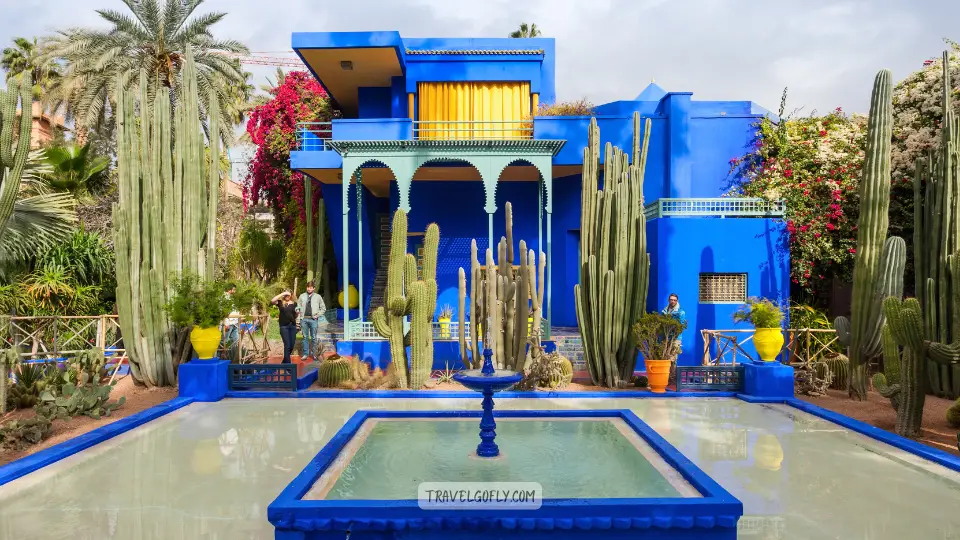 Created by French painter Jacques Majorelle in the 1920s and later owned by fashion designer Yves Saint Laurent, these gardens offer an oasis of calm in bustling Marrakech. The electric blue villa contrasts dramatically with tropical plants from five continents, creating a photographer paradise.
Created by French painter Jacques Majorelle in the 1920s and later owned by fashion designer Yves Saint Laurent, these gardens offer an oasis of calm in bustling Marrakech. The electric blue villa contrasts dramatically with tropical plants from five continents, creating a photographer paradise.
The garden houses the Islamic Art Museum and a Berber Museum showcasing North African cultural heritage. The memorial to Yves Saint Laurent adds a poignant touch to this living artwork where every path reveals new color combinations and plant species.
Insider Tip: Visit early morning (8:00 AM) for the best light and fewer crowds. Entry costs 150 MAD ($15), but the combination ticket with the museum is worthwhile. The gift shop offers unique books and accessories designed by the late couturier.
Time Needed: 1.5-2 hours including museum visits.
9. Explore the Opulent Bahia Palace
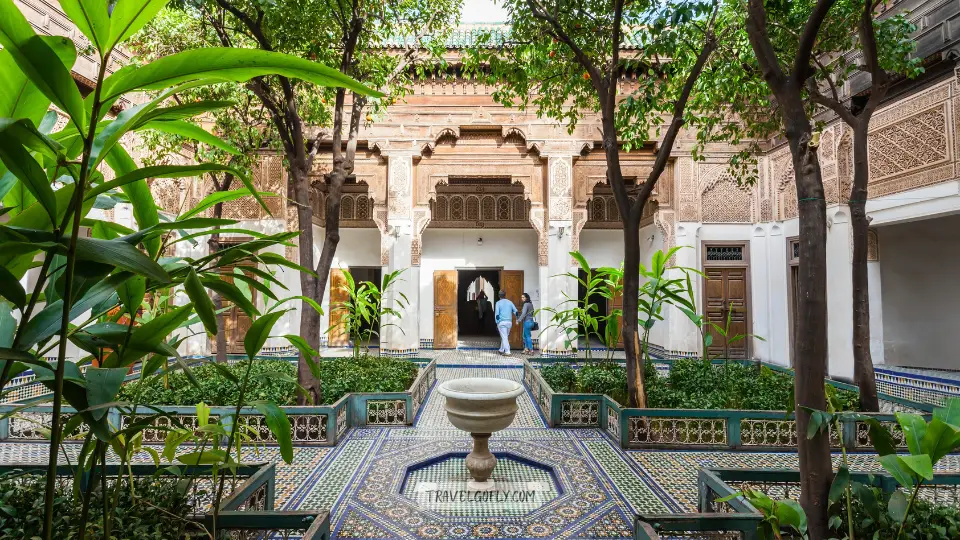 Built in the late 19th century as a harem for Grand Vizier Si Moussa, Bahia Palace represents the pinnacle of Moroccan palatial architecture. The name means “brilliance,” and the palace lives up to its billing with room after room of stunning zellij tilework, painted cedar ceilings, and marble columns.
Built in the late 19th century as a harem for Grand Vizier Si Moussa, Bahia Palace represents the pinnacle of Moroccan palatial architecture. The name means “brilliance,” and the palace lives up to its billing with room after room of stunning zellij tilework, painted cedar ceilings, and marble columns.
The palace complex includes 160 rooms arranged around courtyards filled with orange trees, banana plants, and cypresses. Each salon tells a story of royal life through its unique decorative elements and furniture arrangements.
Insider Tip: The Grand Courtyard photographs best in late afternoon when golden light filters through the arcades. Entry costs 70 MAD ($7). Guided tours provide historical context but aren’t necessary to appreciate the architecture.
Time Needed: 1.5-2 hours to explore thoroughly.
10. Wander Through El Badi Palace Ruins
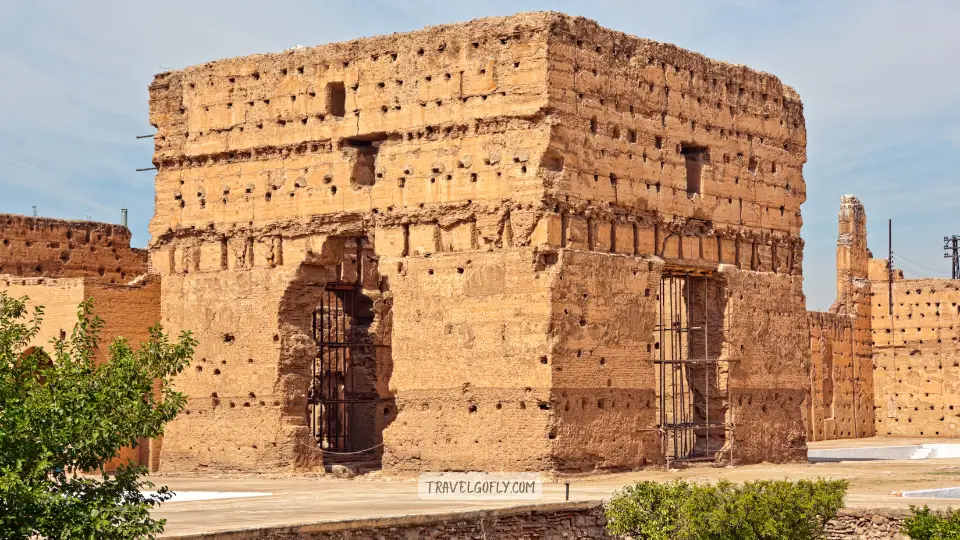
Once called “the wonder of the world” El Badi Palace now stands in magnificent ruins that spark imagination about its former glory. Built by Sultan Ahmad al-Mansur in the 16th century using Italian marble, Irish granite, and gold from Sudan, the palace hosted lavish celebrations that lasted for months.
Today, storks nest atop the remaining walls, and sunken gardens hint at the original splendor. The underground passages and chambers reveal the palace complex infrastructure, while the raised viewpoints offer panoramic views of Marrakech and the Atlas Mountains.
Insider Tip: Climb to the palace ramparts for stunning city views, especially during sunset. The annual Marrakech Popular Arts Festival sometimes uses the ruins as a venue. Entry costs 70 MAD ($7).
Time Needed: 1-1.5 hours including rampart exploration.
11. Discover Secret Menara Gardens
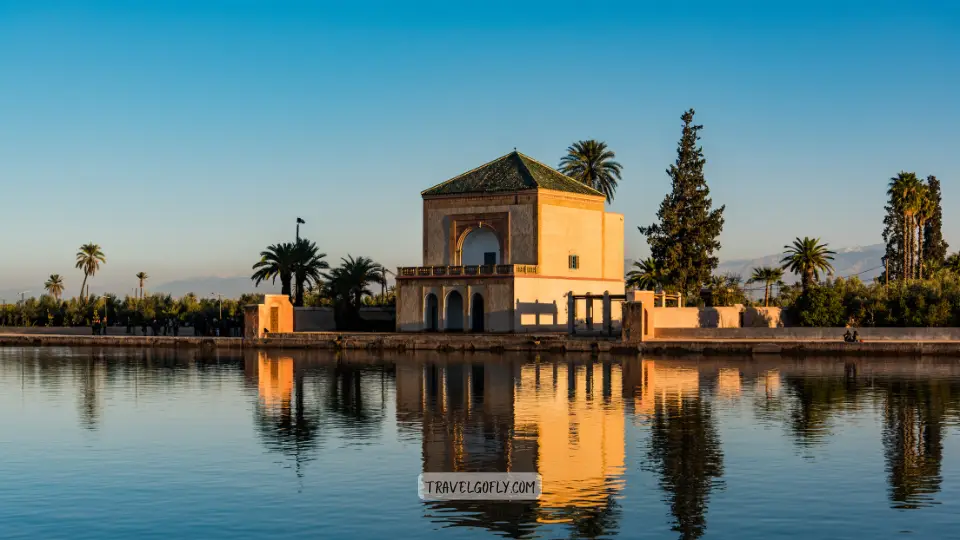 While tourists flock to Majorelle, locals prefer the peaceful Menara Gardens, where olive groves surround a 12th-century pavilion reflected in a tranquil basin. This working garden supplies the city with olives and provides a glimpse into traditional Moroccan agriculture and hydraulic engineering.
While tourists flock to Majorelle, locals prefer the peaceful Menara Gardens, where olive groves surround a 12th-century pavilion reflected in a tranquil basin. This working garden supplies the city with olives and provides a glimpse into traditional Moroccan agriculture and hydraulic engineering.
The pavilion, rebuilt in the 16th century, offers spectacular views of the Atlas Mountains on clear days. Local families picnic here on weekends, creating an authentic atmosphere rarely found in tourist destinations.
Insider Tip: Visit during sunset when the mountains glow behind the pavilion. Entry is free, making it perfect for budget travelers. The olive oil produced here is sometimes available for purchase from local vendors.
Time Needed: 1 hour for a leisurely visit.
Cultural Experiences
12. Indulge in a Traditional Hammam Experience
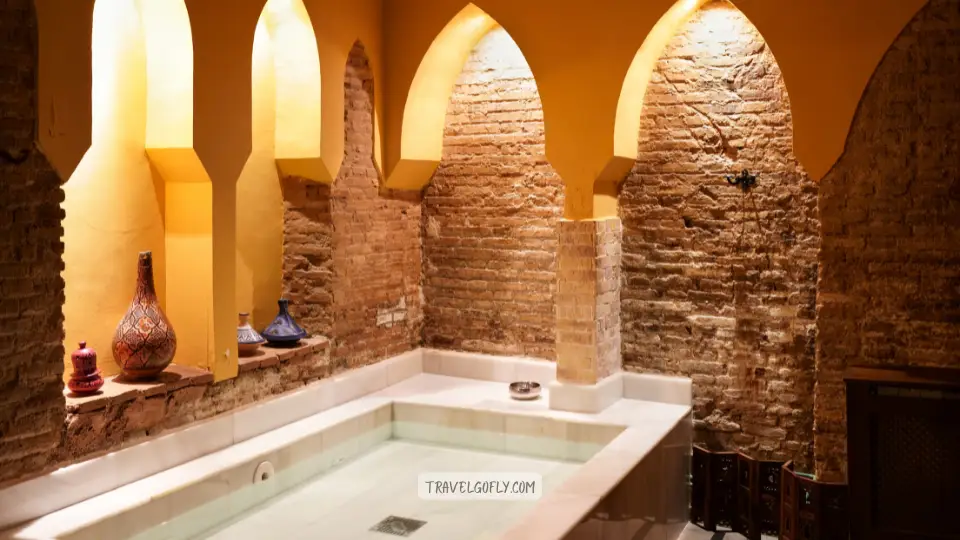 No visit to Marrakech is complete without experiencing a hammam, the traditional Moroccan bathhouse that cleanses both body and soul. These steamy sanctuaries have served as social centers for centuries, where locals gather to relax, socialize, and submit to thorough exfoliation treatments.
No visit to Marrakech is complete without experiencing a hammam, the traditional Moroccan bathhouse that cleanses both body and soul. These steamy sanctuaries have served as social centers for centuries, where locals gather to relax, socialize, and submit to thorough exfoliation treatments.
Choose between tourist-friendly spa hammams with luxury amenities or authentic neighborhood hammams where locals conduct their weekly cleansing rituals. The traditional treatment involves eucalyptus steam, black soap exfoliation with a rough mitt called a kessa, and a relaxing massage.
Insider Tip: Bring flip-flops, towels, and toiletries to authentic hammams. Tourist hammams provide everything but cost significantly more (200-500 MAD vs 30-50 MAD). Women and men have separate areas or designated times.
Time Needed: 1.5-3 hours depending on services chosen.
13. Take a Moroccan Cooking Class
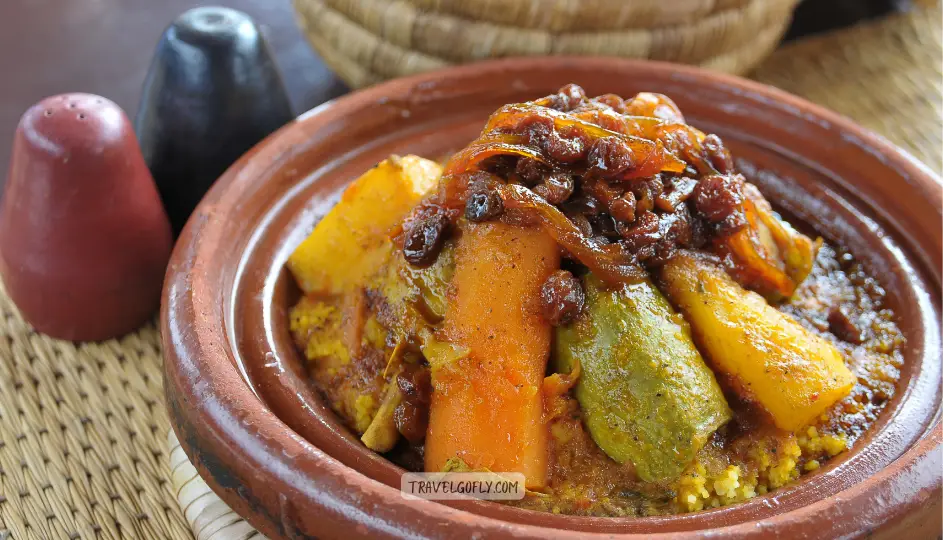 Moroccan cuisine tells the story of cultural exchange through its complex spice blends and cooking techniques inherited from Berber, Arab, and Mediterranean traditions. Hands-on cooking classes reveal the secrets behind perfect tagines, fluffy couscous, and aromatic mint tea.
Moroccan cuisine tells the story of cultural exchange through its complex spice blends and cooking techniques inherited from Berber, Arab, and Mediterranean traditions. Hands-on cooking classes reveal the secrets behind perfect tagines, fluffy couscous, and aromatic mint tea.
Many classes begin with market visits where you’ll select fresh ingredients while learning about local produce and spices. Working alongside skilled cooks, you’ll master techniques like creating the perfect spice blend for each dish and achieving the ideal balance of sweet and savory flavors.
Insider Tip: Book classes through riads or local tour operators for more authentic experiences. Morning classes often include market visits, while evening classes focus on cooking and dining. Prices range from 400-800 MAD ($40-80) per person.
Time Needed: 3-4 hours including market visit and meal.
14. Experience Traditional Gnawa Music
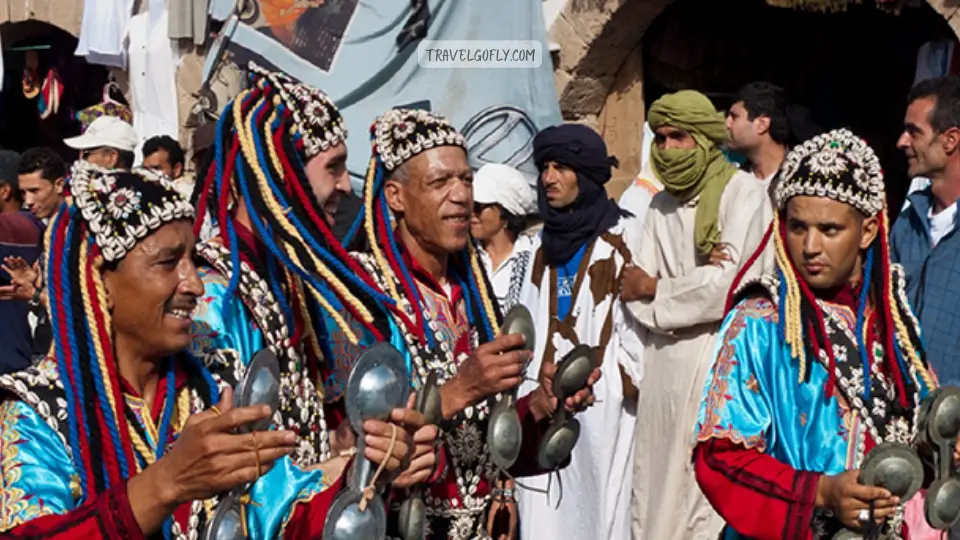 Gnawa music, with its hypnotic rhythms and spiritual significance, represents one of Morocco most distinctive cultural expressions. Descended from sub-Saharan African slaves who brought their musical traditions to Morocco, Gnawa ceremonies combine music, dance, and spiritual healing.
Gnawa music, with its hypnotic rhythms and spiritual significance, represents one of Morocco most distinctive cultural expressions. Descended from sub-Saharan African slaves who brought their musical traditions to Morocco, Gnawa ceremonies combine music, dance, and spiritual healing.
Seek out authentic performances in cultural centers or during the annual Gnawa and World Music Festival. The musicians use metal qarqaba (castanets) and sintirs (bass lutes) to create trance-inducing rhythms that have influenced musicians worldwide.
Insider Tip: The Dar Cherifa cultural center hosts regular Gnawa performances in an intimate riad setting. Evening performances at restaurants like Dar Essalam offer dinner and show combinations. Some performances allow audience participation.
Time Needed: 1.5-2 hours for a complete performance.
Foodie Adventures
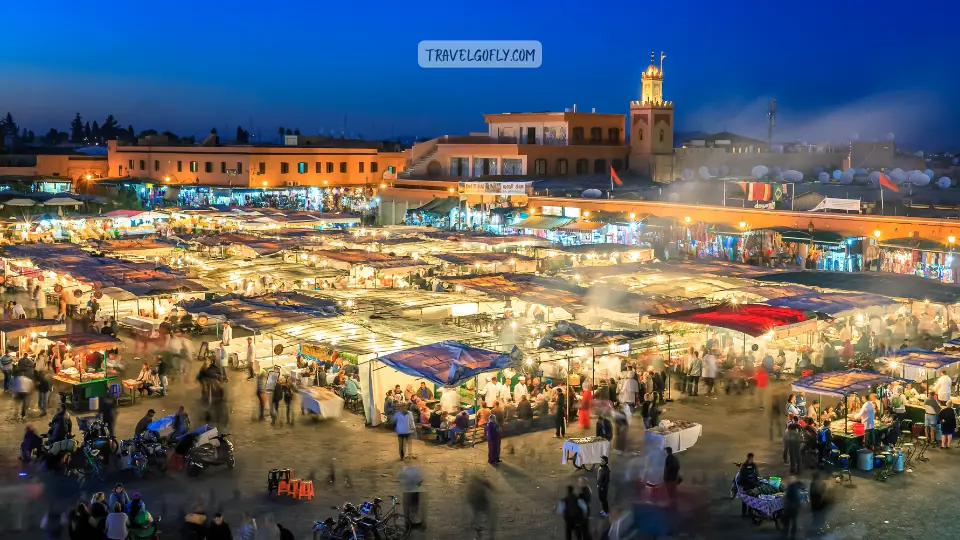 As sunset approaches, Jemaa el-Fna transforms into Morocco largest outdoor restaurant, where dozens of food stalls compete for your attention with sizzling tagines, grilled meats, and exotic delicacies. Each stall specializes in different dishes, from snail soup believed to have medicinal properties to grilled sardines fresh from the coast.
As sunset approaches, Jemaa el-Fna transforms into Morocco largest outdoor restaurant, where dozens of food stalls compete for your attention with sizzling tagines, grilled meats, and exotic delicacies. Each stall specializes in different dishes, from snail soup believed to have medicinal properties to grilled sardines fresh from the coast.
The organized chaos creates an authentic dining experience where locals and tourists share communal tables under gas lanterns. The sight of whole sheep heads, boiled snails, and various organ meats might challenge adventurous eaters, but traditional dishes like maakouda (potato fritters) and harira soup offer familiar flavors.
Insider Tip: Stalls numbered 14, 31, and 84 are popular among locals for quality and fair prices. Always check prices before ordering and don’t be shy about asking to see the ingredients. Evening crowds peak between 7-9 PM.
Time Needed: 1-2 hours for a complete meal and atmosphere absorption.
16. Sample Street Food Throughout the City
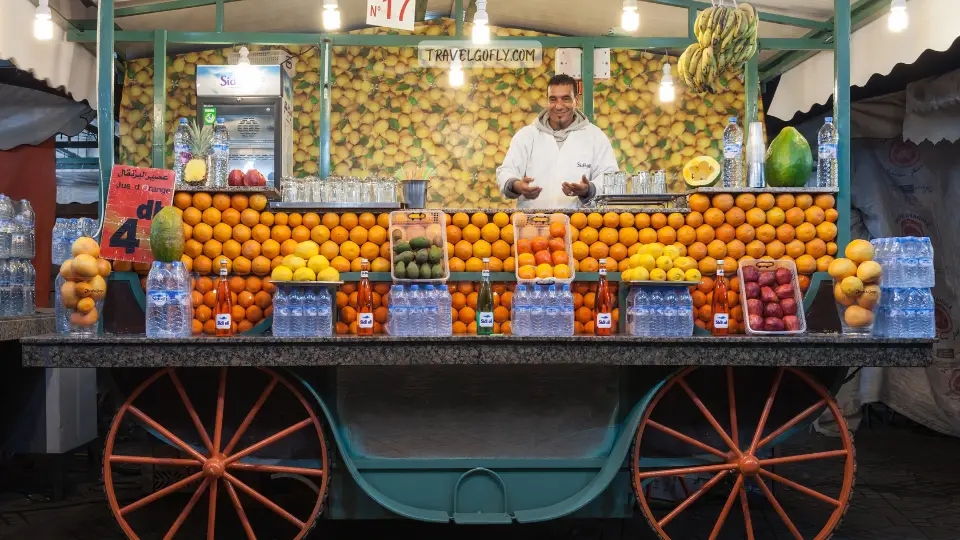 Beyond Jemaa el-Fna, Marrakech street food scene offers countless opportunities to taste authentic flavors at local prices. Morning brings fresh bread from wood-fired ovens, midday features grilled kefta sandwiches and potato cakes, while evening vendors sell everything from sheep head to sweet pastries.
Beyond Jemaa el-Fna, Marrakech street food scene offers countless opportunities to taste authentic flavors at local prices. Morning brings fresh bread from wood-fired ovens, midday features grilled kefta sandwiches and potato cakes, while evening vendors sell everything from sheep head to sweet pastries.
The Mellah (Jewish Quarter) and Gueliz areas offer different specialties, while the souks hide tiny restaurants serving workers meals that showcase home-style cooking rarely experienced by tourists.
Insider Tip: Look for stalls with high turnover among locals this indicates fresh food prepared frequently. Avoid raw vegetables and unpeeled fruits if you have a sensitive stomach. Most vendors accept only cash in small denominations.
Time Needed: Street food grazing can occupy any amount of time from quick snacks to meal replacement.
17. Dine at Traditional Riads
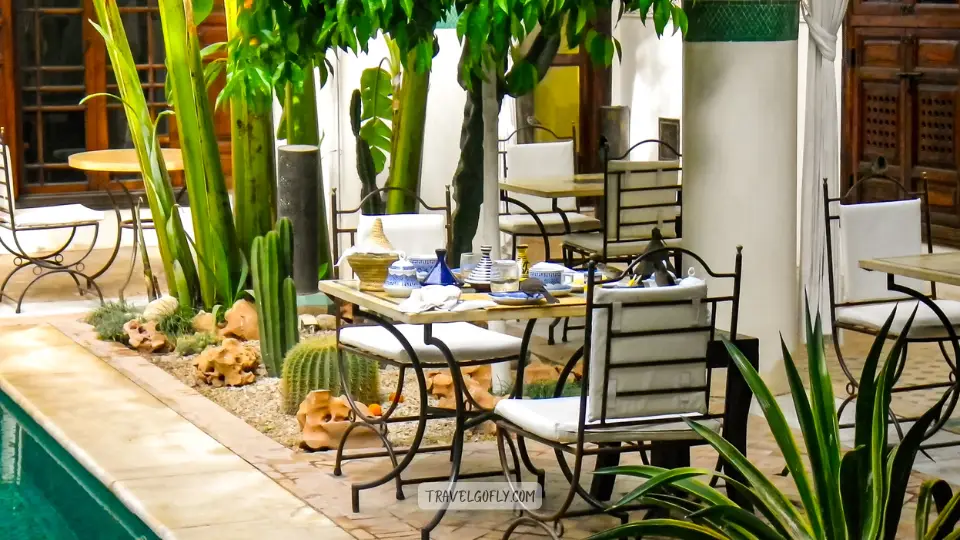 Riad restaurants offer elegant dining experiences in converted traditional houses where central courtyards provide intimate atmospheres under starlit skies. These establishments serve refined versions of Moroccan classics alongside international fusion cuisines that respect local ingredients and traditions.
Riad restaurants offer elegant dining experiences in converted traditional houses where central courtyards provide intimate atmospheres under starlit skies. These establishments serve refined versions of Moroccan classics alongside international fusion cuisines that respect local ingredients and traditions.
The architectural setting enhances the dining experience, with traditional tilework, carved plaster, and trickling fountains creating ambiance that complement carefully crafted menus. Many riads offer rooftop terraces with city views that make dinner feel like a special occasion.
Insider Tip: Reserve ahead for popular riads like Dar Yacout or Nomad. Many offer set menus that provide better value than à la carte ordering. Dress codes tend to be smart casual, and dinner service often begins around 7:30 PM.
Time Needed: 2-3 hours for a complete dining experience.
18. Discover Local Cafes and Mint Tea Culture
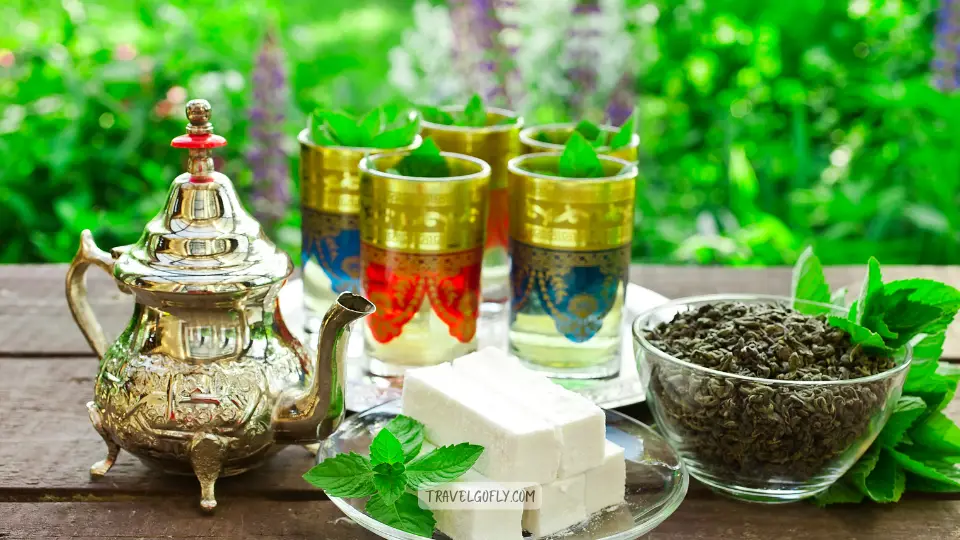 Café culture permeates Marrakech life, where mint tea serves as the universal social lubricant. Local cafes range from hole-in-the-wall establishments serving workers to elegant venues where intellectuals debate politics and literature over endless glasses of sweet tea.
Café culture permeates Marrakech life, where mint tea serves as the universal social lubricant. Local cafes range from hole-in-the-wall establishments serving workers to elegant venues where intellectuals debate politics and literature over endless glasses of sweet tea.
The ritual of preparing mint tea washing the leaves, multiple pours to achieve the perfect foam, serving in small glasses represents hospitality and friendship. Cafes also serve as informal business centers where deals are negotiated and relationships built over hours of conversation.
Insider Tip: Café Clock and Café des Épices offer tourist-friendly atmospheres with roof terraces, while local cafes in Gueliz provide authentic experiences. Tea is usually very sweet request “atay bla sukkar” for unsweetened tea.
Time Needed: 30 minutes to several hours depending on your social inclinations.
Day Trips from Marrakech
19. Journey to the Atlas Mountains
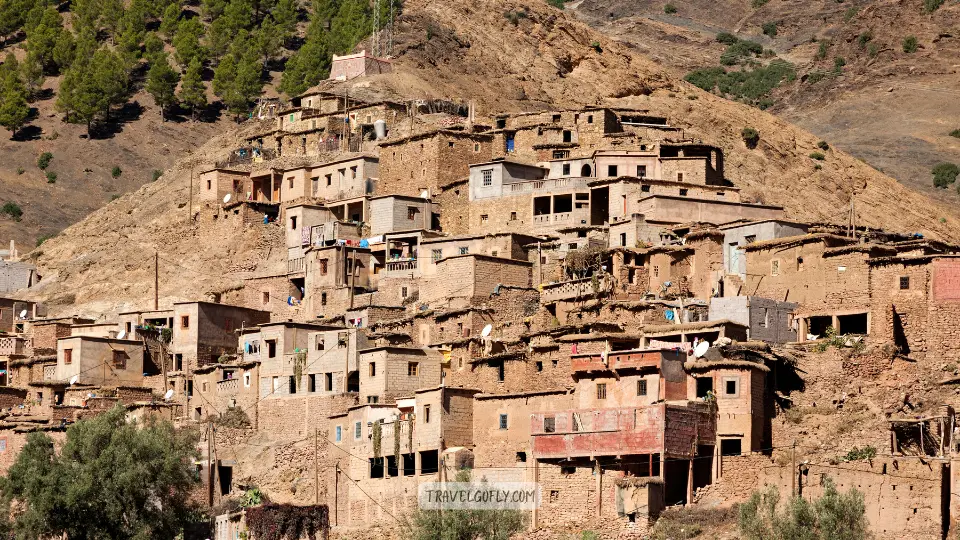 The High Atlas Mountains, visible from Marrakech rooftops, offer dramatic landscape changes within an hour drive. Day trips to Berber villages like Imlil provide insights into traditional mountain life where terraced fields cling to steep slopes and water channels dating to medieval times still irrigate crops.
The High Atlas Mountains, visible from Marrakech rooftops, offer dramatic landscape changes within an hour drive. Day trips to Berber villages like Imlil provide insights into traditional mountain life where terraced fields cling to steep slopes and water channels dating to medieval times still irrigate crops.
These excursions combine cultural immersion with natural beauty, offering hiking opportunities through walnut groves, visits to traditional markets, and encounters with Berber hospitality that includes mint tea served in family homes with stunning mountain views.
Insider Tip: Bring layers as mountain temperatures vary significantly from Marrakech. Friday markets in villages like Asni offer authentic cultural experiences. Many tours include traditional lunch in Berber homes.
Time Needed: Full day (8-10 hours including transport).
20. Explore the Coastal City of Essaouira
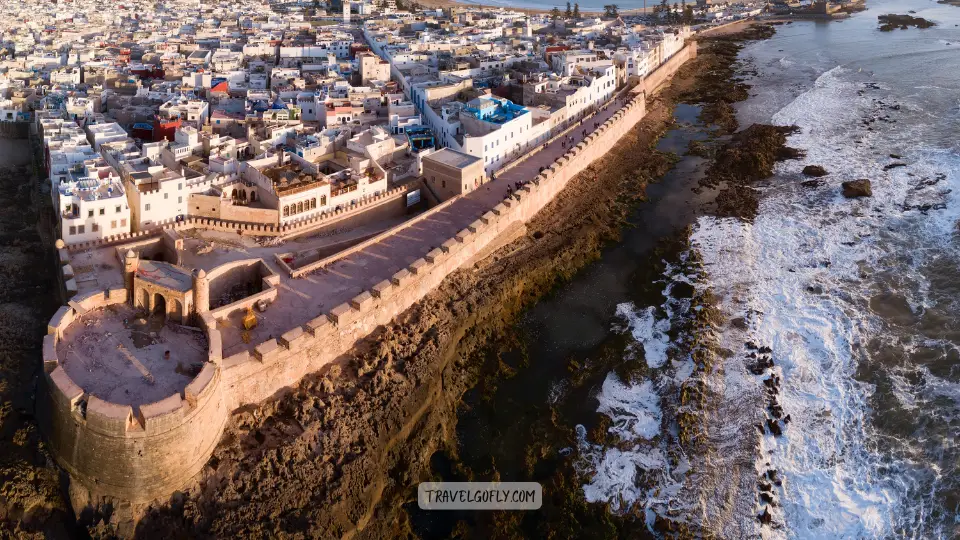 This UNESCO World Heritage port city offers Atlantic Ocean breezes and a laid-back atmosphere that contrasts beautifully with Marrakech intensity. Portuguese and French colonial architecture creates a European feel, while the working fishing port maintains authentic Moroccan character.
This UNESCO World Heritage port city offers Atlantic Ocean breezes and a laid-back atmosphere that contrasts beautifully with Marrakech intensity. Portuguese and French colonial architecture creates a European feel, while the working fishing port maintains authentic Moroccan character.
The medina blue and white buildings, ramparts facing crashing waves, and thriving artisan workshops specializing in thuya wood products create perfect day trip itineraries. Fresh seafood, art galleries, and beach activities provide diverse experiences within the compact historic center.
Insider Tip: The bus journey takes 2.5 hours each way, so consider staying overnight to fully enjoy the relaxed pace. Windsurfing conditions are excellent year-round, and the beach restaurants serve some of Morocco best seafood.
Time Needed: Full day minimum, overnight recommended.
21. Visit the Ourika Valley
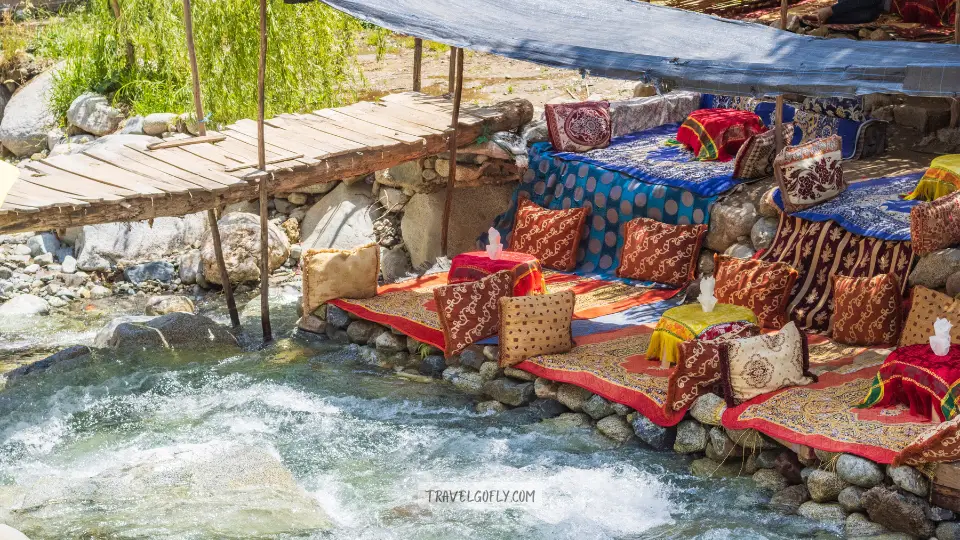 Just 30 kilometers from Marrakech, the Ourika Valley provides an escape into lush landscapes where the Ourika River cascades down from the High Atlas through villages surrounded by fruit trees and vegetable gardens. This popular day trip combines natural beauty with cultural encounters.
Just 30 kilometers from Marrakech, the Ourika Valley provides an escape into lush landscapes where the Ourika River cascades down from the High Atlas through villages surrounded by fruit trees and vegetable gardens. This popular day trip combines natural beauty with cultural encounters.
Local guides lead hikes to the Setti Fatma waterfalls, passing through traditional villages where Berber families maintain agricultural lifestyles unchanged for generations. Riverside restaurants serve fresh trout and tagines while providing respite from valley exploration.
Insider Tip: Visit during spring when fruit trees bloom or autumn for comfortable hiking weather. Shared taxis from Marrakech cost around 25 MAD each way. Bring sturdy shoes for waterfall hikes.
Time Needed: Full day (6-8 hours including transport).
Unique & Off-the-Beaten-Path
22. Discover Secret Gardens and Hidden Riads
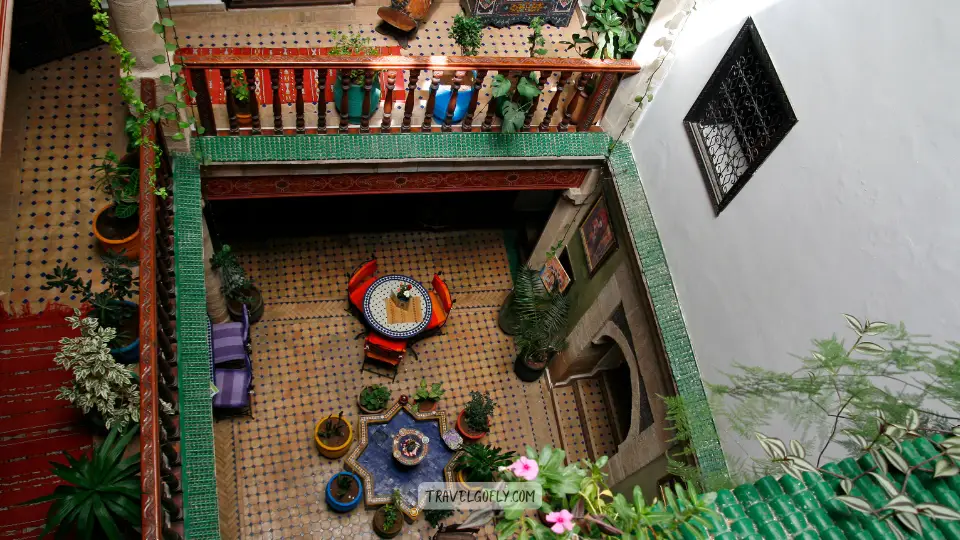 Beyond famous gardens, Marrakech hides numerous smaller oases accessible to curious travelers. Many traditional riads open their courtyards to visitors, offering intimate glimpses of domestic architecture and family life while providing peaceful retreats from souk negotiations and tourist crowds.
Beyond famous gardens, Marrakech hides numerous smaller oases accessible to curious travelers. Many traditional riads open their courtyards to visitors, offering intimate glimpses of domestic architecture and family life while providing peaceful retreats from souk negotiations and tourist crowds.
These hidden gems often feature unique collections, from contemporary art installations to traditional craft demonstrations. Some operate as cultural centers offering workshops, exhibitions, or performance spaces that showcase local creativity.
Insider Tip: Many riad owners welcome respectful visitors during afternoon hours. The Maison de la Photographie offers excellent rooftop views and historical photo exhibitions. Always ask permission before photography in private riads.
Time Needed: 30 minutes to 1 hour per location.
23. Explore the Tanneries
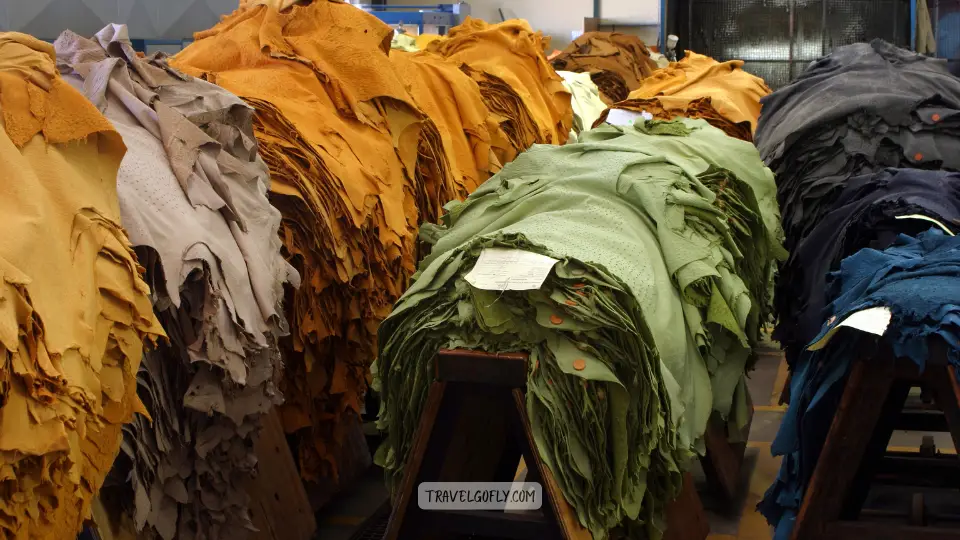 The leather tanneries represent one of the world oldest manufacturing processes, unchanged for centuries in their basic techniques. These workshops, hidden in the medina depths, transform raw animal hides into supple leather using natural ingredients like pigeon droppings, cow urine, and plant-based dyes.
The leather tanneries represent one of the world oldest manufacturing processes, unchanged for centuries in their basic techniques. These workshops, hidden in the medina depths, transform raw animal hides into supple leather using natural ingredients like pigeon droppings, cow urine, and plant-based dyes.
The sight of colorful dyeing vats arranged like a medieval painter palette creates striking photographic opportunities, though the intense smells require strong stomachs. Workers demonstrate traditional techniques while explaining the months-long process that creates Morocco famous leather goods.
Insider Tip: Guides often provide mint leaves to mask odors. Best viewing is from surrounding rooftops rather than ground level. Purchase leather goods directly from tannery shops for better prices and quality assurance.
Time Needed: 45 minutes to 1 hour.
24. Visit Local Art Galleries
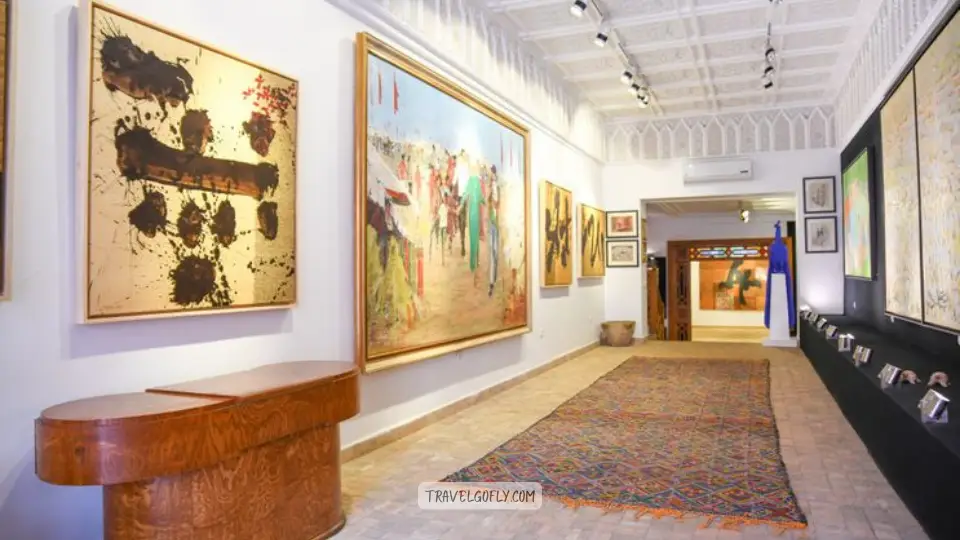 Marrakech contemporary art scene thrives in galleries and cultural centers that showcase emerging Moroccan and international artists. These spaces often occupy converted riads where traditional architecture provides striking backdrops for modern creative expressions.
Marrakech contemporary art scene thrives in galleries and cultural centers that showcase emerging Moroccan and international artists. These spaces often occupy converted riads where traditional architecture provides striking backdrops for modern creative expressions.
The Marrakech Biennale and regular exhibitions introduce visitors to current artistic movements blending traditional themes with contemporary techniques. Many galleries also host workshops, artist talks, and cultural events that provide deeper insight into Morocco evolving creative landscape.
Insider Tip: The David Bloch Gallery and Galerie Noir sur Blanc represent cutting-edge contemporary art. Many galleries close during midday heat (12-3 PM). Opening receptions offer opportunities to meet artists and local art enthusiasts.
Time Needed: 30-45 minutes per gallery.
Nightlife & Evening Activities
25. Experience Rooftop Dining and Drinks
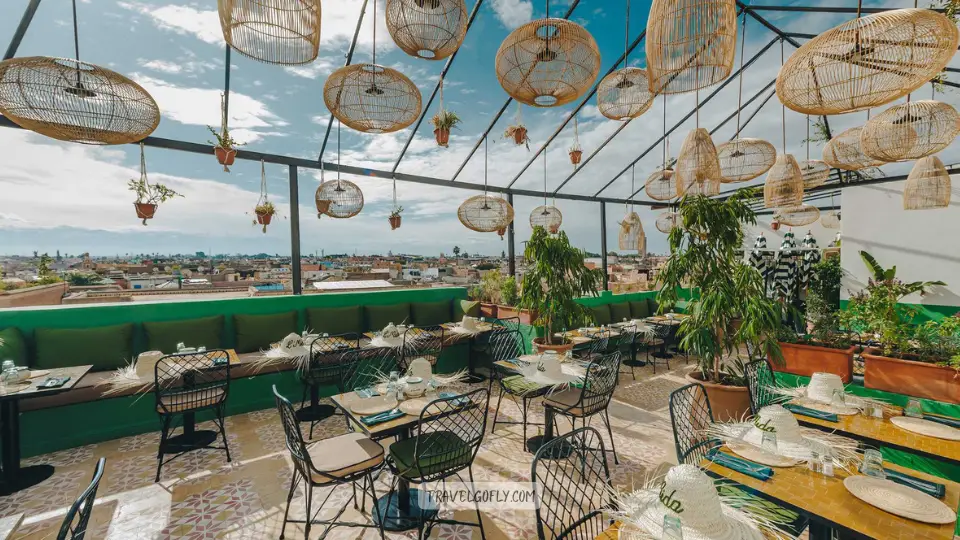 Marrakech skyline, dominated by the Koutoubia Mosque and punctuated by palm trees, provides magical backdrops for rooftop dining experiences. These elevated venues offer panoramic views of the medina terracotta buildings and the distant Atlas Mountains while serving everything from traditional tagines to international fusion cuisine.
Marrakech skyline, dominated by the Koutoubia Mosque and punctuated by palm trees, provides magical backdrops for rooftop dining experiences. These elevated venues offer panoramic views of the medina terracotta buildings and the distant Atlas Mountains while serving everything from traditional tagines to international fusion cuisine.
Many rooftops transform from daytime cafes to sophisticated evening venues where DJ sets and live music complement starlit dining. The atmosphere ranges from bohemian lounges to upscale establishments frequing by celebrities and international visitors.
Insider Tip: Book sunset tables well in advance at popular venues like Sky Bar or Terrass'”. Prices increase significantly after dark, but the atmosphere and views justify the cost. Many venues have dress codes for evening service.
Time Needed: 2-3 hours for dinner and drinks.
26. Enjoy Traditional Entertainment Shows
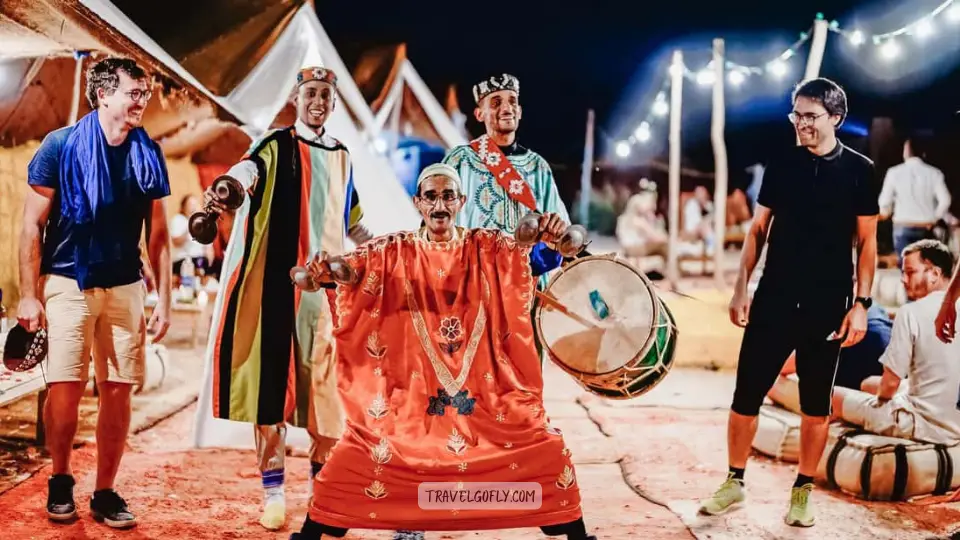 Evening entertainment in Marrakech ranges from dinner shows featuring folkloric performances to contemporary venues hosting international DJs. Traditional shows typically include Berber dancing, Gnawa music, and sometimes belly dancing, all performed in atmospheric settings that transport guests into Morocco cultural heritage.
Evening entertainment in Marrakech ranges from dinner shows featuring folkloric performances to contemporary venues hosting international DJs. Traditional shows typically include Berber dancing, Gnawa music, and sometimes belly dancing, all performed in atmospheric settings that transport guests into Morocco cultural heritage.
Venues like Der Essalam and Comptoire Darna combine fine dining with elaborate productions featuring costumed performers, while smaller venues offer more intimate experiences with local musicians and storytellers.
Insider Tip: Dinner shows usually begin around 8:30 PM with meals served first. Photography may be restricted during performances. Some venues allow entrance for drinks only if you prefer to skip the meal.
Time Needed: 3-4 hours for complete dinner and show packages.
Free Things to Do
27. Explore the Medina Architecture
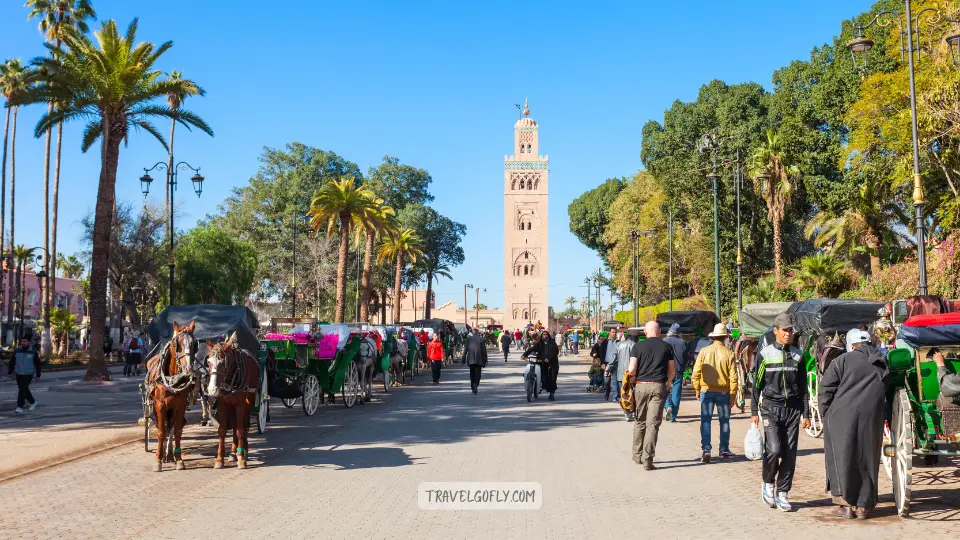 The Marrakech medina offers free architectural education through its maze of streets where every building tells historical stories through decorative elements, construction techniques, and spatial organization. Traditional riad architecture, with its inward-facing design around central courtyards, reflects Islamic principles of privacy and family life.
The Marrakech medina offers free architectural education through its maze of streets where every building tells historical stories through decorative elements, construction techniques, and spatial organization. Traditional riad architecture, with its inward-facing design around central courtyards, reflects Islamic principles of privacy and family life.
Public buildings like the Medersa Ben Youssef (when free admission days occur) and mosque courtyards accessible to non-Muslims demonstrate sophisticated construction techniques using local materials like tadelakt plaster, zellij tilework, and carved cedar wood.
Insider Tip: Early morning and late afternoon provide the best natural lighting for architectural photography. Many building details are visible from public streets without entering private properties. Respect privacy by not peering into residential courtyards.
Time Needed: Several hours to days depending on your architectural interests.
28. People-Watch in Public Squares
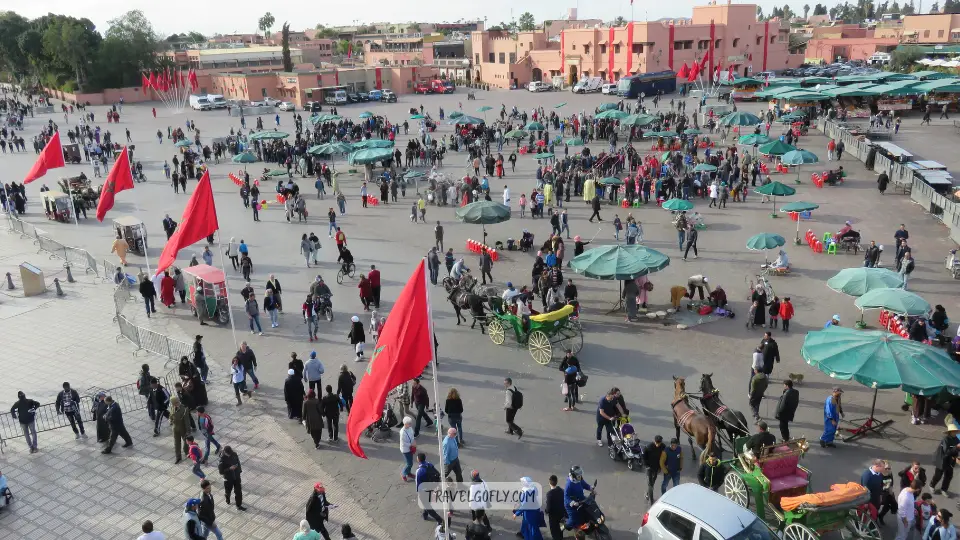 Beyond Jemaa el-Fna, Marrakech offers numerous squares and gathering spaces where local life unfolds throughout the day. These animated stages provide endless entertainment as vendors, performers, and ordinary citizens create impromptu theater through their daily interactions.
Beyond Jemaa el-Fna, Marrakech offers numerous squares and gathering spaces where local life unfolds throughout the day. These animated stages provide endless entertainment as vendors, performers, and ordinary citizens create impromptu theater through their daily interactions.
Place des Ferblantiers near the Saadian Tombs and the smaller squares within the souk system offer more intimate people-watching opportunities where you can observe authentic local interactions without the tourist-focused performances of the main square.
Insider Tip: Cafe terraces provide comfortable vantage points for extended observation. Bring a book or journal to appear less obvious while people-watching. Tipping street performers is optional but appreciated.
Time Needed: As long as you find the human drama entertaining.
29. Wander Through Free Gardens and Parks
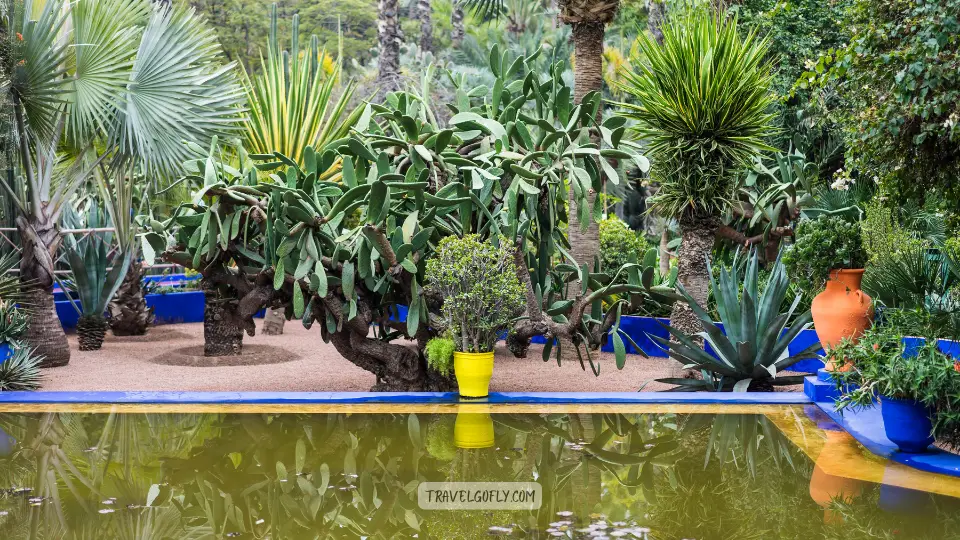 Several public gardens and parks provide free green spaces where locals exercise, children play, and families gather for picnics. These areas offer respite from the medina intensity while providing insight into modern Marrakech life and recreational habits.
Several public gardens and parks provide free green spaces where locals exercise, children play, and families gather for picnics. These areas offer respite from the medina intensity while providing insight into modern Marrakech life and recreational habits.
The Cyber Park near the train station combines traditional landscaping with modern amenities like free Wi-Fi, making it popular with students and digital nomads. Smaller neighborhood parks scattered throughout the city offer authentic slice-of-life experiences.
Insider Tip: Public gardens are busiest during evenings and weekends when families utilize the space. Some gardens may charge nominal entry fees for maintenance but many remain completely free.
Time Needed: 30 minutes to 2 hours depending on your relaxation needs.
Free Things to Do in Marrakech with Kids
30. Visit Child-Friendly Attractions
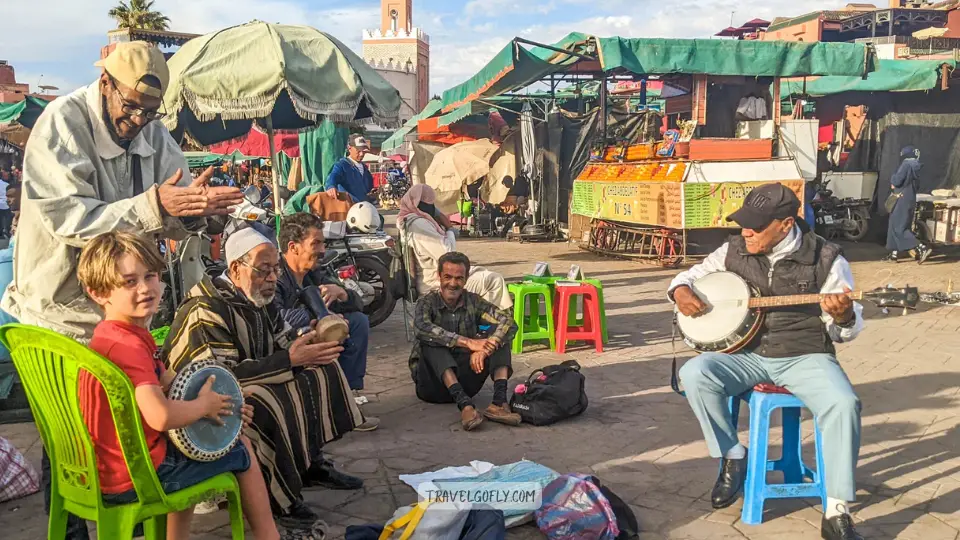 Marrakech offers numerous family-friendly activities that engage children while introducing them to Moroccan culture. The city sensory richness from souk smells to street performer sounds creates memorable experiences for young travelers when approached with proper preparation and realistic expectations.
Marrakech offers numerous family-friendly activities that engage children while introducing them to Moroccan culture. The city sensory richness from souk smells to street performer sounds creates memorable experiences for young travelers when approached with proper preparation and realistic expectations.
Interactive experiences like henna painting, pottery workshops, and cooking classes designed for families provide hands-on cultural education. Many palaces and gardens offer space for children to explore while parents appreciate historical and architectural details.
Insider Tip: Plan shorter itineraries with frequent breaks for food and rest. Many restaurants provide high chairs and children menus, though traditional dishes may be too spicy for young palates. Staying in riads with pools helps children cool off during hot afternoons.
Time Needed: Adjust all suggested timeframes downward when traveling with children.
31. Enjoy Family-Friendly Entertainment
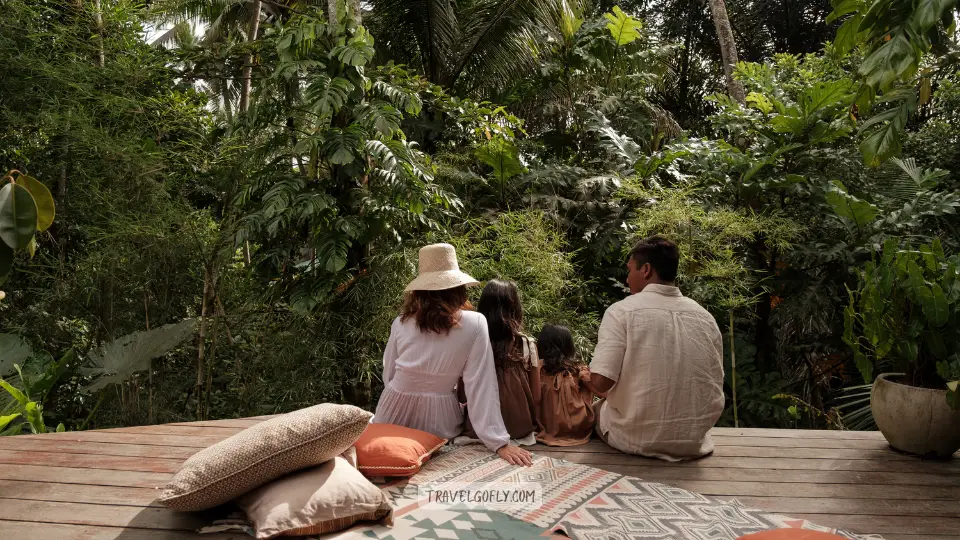 Street performers in Jemaa el-Fna often engage children with magic tricks, acrobatics, and interactive demonstrations that transcend language barriers. The square energy excites kids, though parents should maintain close supervision in crowded areas.
Street performers in Jemaa el-Fna often engage children with magic tricks, acrobatics, and interactive demonstrations that transcend language barriers. The square energy excites kids, though parents should maintain close supervision in crowded areas.
Several venues offer family-oriented evening entertainment featuring puppet shows, storytelling in multiple languages, and cultural performances designed to educate and entertain audiences of all ages.
Insider Tip: Late afternoon visits to Jemaa el-Fna work better for families than evening hours when crowds become overwhelming. Many hotels and riads can arrange private cultural performances for families with young children.
Time Needed: 1-2 hours for street performance enjoyment.
Planning Your Perfect Marrakech Trip
Best Time to Visit
Marrakech desert climate creates distinct seasonal experiences that significantly impact your visit. Spring (March-May) and autumn (September-November) offer ideal weather with warm days and cool evenings perfect for exploring outdoor attractions and dining on rooftops.
Summer temperatures (July-August) often exceed 40°C (104°F), making midday activities uncomfortable though early morning and evening hours remain pleasant. Winter (December-February) brings cooler temperatures ideal for daytime exploration, though evenings can require warm clothing and heating in traditional riads.
Ramadan affects restaurant hours and alcohol availability, while local festivals like the Popular Arts Festival and Marathon impact accommodation prices and availability.
Getting There and Around
Mohammed V International Airport in Casablanca serves most international flights with connecting flights to Marrakech-Menara Airport. Direct international flights to Marrakech continue increasing, though connecting through European hubs often provides more scheduling flexibility.
Within Marrakech, walking remains the best way to explore the medina narrow alleys where cars cannot navigate. Petit taxis (small red cars) serve destinations within the city limits while grand taxis provide transport to nearby attractions like the Atlas Mountains.
Transportation Tips: Download offline maps before arrival as GPS can be unreliable in the narrow medina streets. Negotiate taxi fares in advance or insist on using meters. Many riads arrange airport transfers for arriving guests.
Where to Stay in Marrakech
Luxury Riads: La Mamounia, Royal Mansour, and other five-star properties offer ultimate comfort with world-class spas, fine dining, and impeccable service starting around $500-1000 per night.
Mid-Range Riads: Family-owned properties like Riad Tamsna or Riad Dar Anika provide authentic charm with modern amenities for $100-300 per night, often including breakfast and airport transfers.
Budget Options: Hostels, small riads, and guesthouses offer clean accommodation for $20-60 per night, though amenities may be basic and locations might require longer walks to main attractions.
Modern Hotels: International chains in Gueliz (new city) provide familiar comforts for guests preferring contemporary facilities over traditional architecture.
Culture and Etiquette
Morocco Islamic culture influences daily life through prayer times, modest dress expectations, and social interactions. Respecting these customs enhances your experience and demonstrates cultural sensitivity appreciated by locals.
Dress Code: Cover shoulders and knees when visiting religious sites. Modest dress throughout the city shows respect, though tourist areas are more relaxed.
Photography: Always ask permission before photographing people. Many attractions charge photography fees for professional equipment.
Bargaining: Negotiating is expected in souks and with street vendors. Start at 30% of the initial asking price and negotiate gradually.
Tipping: Small tips (10-20 MAD) are appreciated for services like guiding, carrying bags, or providing directions.
Food and Dining
Moroccan cuisine offers incredible flavors but may challenge sensitive stomachs. Take sensible precautions while remaining open to culinary adventures that define authentic travel experiences.
Safety Tips: Drink bottled water, avoid raw vegetables in street food, and choose restaurants with high customer turnover indicating fresh ingredients.
Must-Try Dishes: Tagines, couscous, pastilla, harira soup, and mint tea represent essential flavors. Street food like maakouda (potato cakes) and traditional bread provide budget-friendly options.
Dietary Restrictions: Vegetarian and vegan options exist but may be limited outside tourist-oriented restaurants. Alcohol is available in licensed restaurants and bars but not widely consumed by locals.
Safety and Common Scams
Marrakech is generally safe for tourists, but staying aware of common scams helps avoid unpleasant experiences. Most locals are helpful and honest, but tourist areas attract opportunists seeking easy targets.
Common Scams: Fake guides demanding payment, overpriced “carpet demonstrations” and aggressive sellers in souks. Politely but firmly decline unwanted services.
Safety Tips: Keep valuables secure, stay aware of surroundings in crowds, and trust your instincts if situations feel uncomfortable. Solo female travelers should dress modestly and may prefer group tours for certain activities.
Budgeting Your Trip
Daily costs in Marrakech vary dramatically based on choices and preferences. Budget travelers can survive on $30-50 per day, while luxury seekers may spend $300-500 daily for premium experiences.
Budget Breakdown:
- Accommodation: $20-300 per night
- Meals: $5-50 per person per meal
- Transportation: $2-20 per journey
- Attractions: $5-15 entry fees
- Shopping: Variable based on interests
Money-Saving Tips: Eat at local establishments, shop in local markets rather than tourist souks, and walk whenever possible. Many cultural experiences like architectural appreciation and people-watching cost nothing.
Packing Essentials
Pack for temperature variations, cultural considerations, and activities you plan to enjoy. Morocco desert climate creates significant temperature swings between day and night, especially during winter months when afternoon warmth gives way to surprisingly cool evenings.
Essential Items: Comfortable walking shoes for cobblestone streets, modest clothing covering shoulders and knees, sunscreen and hat for protection against intense UV rays, layers for temperature changes, and a small backpack for day excursions.
Specific Recommendations: Bring hand sanitizer and tissues as public restrooms may lack supplies, a portable phone charger for long days of exploration, cash in small denominations for tips and small purchases, and any prescription medications as availability may be limited.
Seasonal Considerations: Summer requires lightweight, breathable fabrics and extra sun protection, while winter necessitates warm layers for evening activities. Spring and autumn offer the most comfortable packing with moderate clothing needs.
Responsible Tourism
Visiting Marrakech responsibly ensures that tourism benefits local communities while preserving cultural heritage and natural environments for future generations. Your choices as a traveler can positively impact the destination and its people.
Support Local Businesses: Choose locally-owned restaurants, riads, and tour operators over international chains. Purchase authentic crafts directly from artisans rather than mass-produced souvenirs, and hire local guides who provide insider knowledge while earning fair wages.
Cultural Respect: Learn basic Arabic or French phrases to show respect for local languages. Understand that Morocco is a Muslim country where religious practices influence daily life, and adjust your behavior accordingly during prayer times and religious holidays.
Environmental Consciousness: Minimize plastic waste by carrying a reusable water bottle and shopping bags. Respect natural areas during Atlas Mountain excursions by following Leave No Trace principles, and consider carbon offset programs for international flights.
Fair Economic Impact: Negotiate fairly during souk shopping—while bargaining is expected, ensure prices remain reasonable for both parties. Tip service providers appropriately, and consider the economic impact of your choices on local communities.
Why Trust This Guide?
This comprehensive guide to Marrakech attractions and experiences draws from extensive on-ground research, multiple visits to the Red City across different seasons, and ongoing relationships with local guides, artisans, and hospitality professionals who call Marrakech home.
The recommendations balance must-see attractions with off-the-beaten-path discoveries, providing options for every travel style from budget backpackers to luxury travelers. Each suggestion has been personally visited and evaluated for authenticity, safety, and value to ensure you experience the best of what Marrakech offers.
Regular updates incorporate feedback from fellow travelers, seasonal changes affecting attractions, and evolving price information to maintain accuracy. The focus remains on sustainable tourism practices that benefit both visitors and the local community while preserving Marrakech unique cultural heritage.
Your Marrakech Adventure Awaits
Marrakech isn’t just a destination it’s a sensory journey that will challenge your perceptions, delight your senses, and create memories lasting far beyond your departure. From the hypnotic chaos of Jemaa el-Fna to the serene beauty of secret gardens, from the ancient wisdom of madrasas to the vibrant creativity of contemporary galleries, every corner of this imperial city offers new discoveries.
The magic of Marrakech lies not just in its historic monuments or beautiful gardens, but in the intersection of past and present where traditional craftsmen work alongside contemporary artists, where ancient call to prayer echoes through streets filled with modern cafes, and where travelers from around the world gather to experience something absolutely unique.
Whether you have three days or three weeks, whether you’re drawn by history, cuisine, architecture, or adventure, Marrakech will exceed your expectations and leave you planning your return before you’ve even departed. The Red City has a way of capturing hearts, and this guide has given you the keys to unlock its many treasures.
Ready to explore? Start planning your Marrakech adventure today, and prepare for a journey that will awaken all your senses and expand your understanding of this incredible crossroads of cultures.
Questions about your trip? Share your thoughts and experiences in the comments below fellow travelers love hearing about others adventures and offering additional tips for making the most of Marrakech wonders.
Planning your itinerary? Bookmark this guide and check out our recommended tour partners and booking resources to help you create the perfect Marrakech experience tailored to your interests and budget.
